Most people crumple up their used aluminum foil and toss it straight into the trash after one meal. That shiny kitchen staple sitting in your drawer has way more life left in it than you realize. From clever household hacks to proper recycling techniques, aluminum foil can serve multiple purposes before it needs to be discarded. Understanding the right ways to reuse and dispose of this versatile material can save money and reduce waste in your home.
Clean foil can be used multiple times
That piece of foil you used to cover last night’s casserole doesn’t need to hit the trash immediately. If the foil isn’t heavily soiled or torn, it can easily handle another round of food storage or cooking tasks. Simply wipe it down with a damp cloth or rinse it under warm water to remove any food particles. The aluminum material is surprisingly durable and maintains its protective properties even after several uses.
Many people don’t realize that aluminum foil can even go in the dishwasher for thorough cleaning. Place it on the top rack and secure it with something heavy to prevent it from flying around during the wash cycle. This method works particularly well for foil pans and takeout containers that you want to reuse for meal prep or storage purposes.
Foil works great for household cleaning tasks
Before tossing that used foil, consider putting it to work around the house. Crumpled aluminum foil makes an excellent scrubber for cleaning grills, removing burnt-on food from pans, and even sharpening scissors. The abrasive texture helps remove stubborn grime without scratching most surfaces. It’s particularly effective at cleaning barbecue grates when they’re still slightly warm from cooking.
Another surprising cleaning trick involves adding a ball of foil to your silverware holder when running the dishwasher. This simple hack helps remove tarnish and keeps your utensils looking shiny. The foil also helps prevent rust on metal items during the wash cycle, making it a useful addition to your regular cleaning routine.
Storage mistakes reduce foil effectiveness
Using aluminum foil for long-term food storage seems convenient, but it’s not the best choice for keeping leftovers fresh. Unlike proper storage containers, foil doesn’t create an airtight seal, allowing air to reach your food and promote bacterial growth. This can lead to faster spoilage and potential food safety issues, especially with dairy and meat products.
The lack of proper sealing also causes moisture loss, leaving your leftovers dried out and less appetizing. Food safety experts recommend using airtight containers made from glass, food-grade silicone, or BPA-free plastic for storing leftovers. These containers preserve freshness better and reduce the risk of contamination from airborne bacteria.
Acidic foods cause aluminum to leach
Tomato-based sauces, citrus fruits, and vinegar-based marinades don’t play well with aluminum foil. The acids in these foods can cause the foil to break down and leach aluminum particles into your meal, creating an unpleasant metallic taste. This reaction happens more quickly when the acidic food sits in contact with foil for extended periods or when heated together.
For acidic foods, stick to glass, ceramic, or stainless steel containers that won’t react with the ingredients. If you must use foil with these foods, limit the contact time and avoid storing them together overnight. Food safety guidelines suggest using parchment paper or other non-reactive materials when dealing with highly acidic ingredients to maintain both safety and taste quality.
Microwave use creates dangerous sparks
That leftover slice of pizza wrapped in foil needs to be unwrapped before it goes in the microwave. Metal and microwaves don’t mix safely, as the electromagnetic waves bounce off the foil and can create sparks, small fires, or damage to your microwave’s interior. Even small pieces of foil can cause problems, so check that your food is completely foil-free before heating.
The sparks aren’t just dramatic – they can actually damage your microwave’s magnetron, the component that generates the microwaves. This type of damage often requires expensive repairs or complete appliance replacement. When reheating foil-wrapped leftovers, transfer the food to a microwave-safe dish or use parchment paper as a safe covering alternative.
Direct flames can weaken and melt foil
While aluminum foil works great for indirect grilling, placing it directly over open flames can cause problems. The intense heat can weaken the foil, causing it to tear or even melt, potentially releasing particles onto your food. Regular-weight foil is particularly susceptible to this type of damage, while heavy-duty versions fare slightly better but still aren’t ideal for direct flame contact.
Direct flame exposure also blocks airflow around your food, creating hot spots that lead to uneven cooking. Instead of using foil directly over flames, try indirect grilling methods or invest in proper grill mats designed to handle high temperatures. These alternatives provide better heat distribution and won’t break down under intense conditions.
Baking with foil can ruin your results
Lining baking sheets with aluminum foil might seem like an easy cleanup solution, but it can actually sabotage your baking results. Foil conducts heat much more efficiently than parchment paper, causing cookies and other baked goods to brown too quickly on the bottom while remaining undercooked on top. This uneven heat distribution leads to disappointing results and potentially burned treats.
The high conductivity also means your baked goods might cook faster than expected, throwing off carefully timed recipes. Parchment paper or silicone baking mats provide better heat distribution and don’t interfere with cooking times. These alternatives are also reusable and create less waste than single-use foil sheets, making them both practical and economical choices for regular baking.
Oven lining causes temperature regulation problems
Covering your oven bottom with foil to catch spills seems logical, but it creates more problems than it solves. The reflective surface interferes with your oven’s heat circulation and temperature sensors, leading to inaccurate readings and uneven cooking. This can cause your oven to overheat in some areas while leaving other spots too cool, affecting everything you cook.
The disrupted heat flow can also damage your oven’s heating elements and thermostat over time, potentially leading to costly repairs. Instead of lining the oven bottom, place a baking sheet on the rack below your food to catch drips. This method protects your oven without interfering with its normal operation or creating safety hazards from overheating components.
That roll of aluminum foil in your kitchen drawer has plenty of life left in it with proper care and creative reuse. From cleaning tasks to proper recycling preparation, understanding how to maximize its usefulness saves money and reduces waste. Just remember to avoid the common mistakes that can compromise food safety or damage your appliances, and your foil will serve you well beyond its first use.

